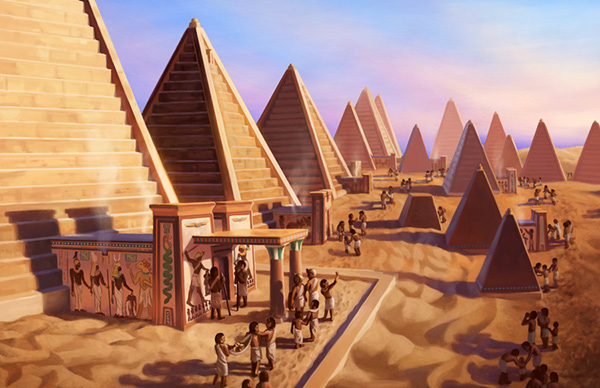
Did you know Sudan has almost twice as many Pyramids as Egypt? To be precise, Sudan has 255 pyramids scattered across the country. Egypt, on the other hand, has “only” 132 pyramids. The Sudanese Pyramids belong to Egypt’s 25th dynasty, known as the Kushite Empire.
The Egyptian ones are older, but we have to mention Sudan and its beautiful pyramids as well.
Pyramids in Sudan are mostly known under the name Nubian Pyramids. They were built by the rulers of the ancient Kushite kingdom. Located in the area of Nile known as Nubia, they lie within the north of present-day Sudan.
Present-day Sudan was home to three Kushite kingdoms. The first one, with its capital at Kerma, from 2500 to 1500 BC, the second one with its capital in Napata from 1000 to 300 BC, and the last one, with its capital in Meroe, lasting from 300 BC to AD 300.
Influenced by the Egyptians, Nubian kings built their own pyramids thousands of years ago. The first known pyramid in Sudan (or Nubia), came to existence in 751 BC. These pyramids emulated a form of Egyptian private elite family pyramids built during the New Kingdom.

Fun fact: more than 40 of these Nubian pyramids were partially demolished by Italian treasure hunter, Giuseppe Ferlini in the 1830s.
Today, these pyramids are recognized as a UNESCO World Heritage Site. They were built to serve as tombs for the kings and queens, as well as wealthy citizens of the cities Meroe and Napata.
Later on, pyramids were built at Nuri, location 10km north on the opposite bank of the Nile. As a burial place of 21 kings and 52 queens, this pyramid also serves as the home for Anlami and Aspelta.
The oldest and largest pyramid in Sudan is the one of the Napatan king and Twenty-fifth dynasty pharaoh, Taharga.
Here are some cemeteries in Sudan:
- Royal cemetery at el-Kurru, housing Kashta, Pive, Tantamani, Shabaka, and many more queens
- Pyramids of Gebel Barkal
- Royal cemetery at Nuri, housing Kings Taharga, Atlanersa, and other royals from the kingdom of Napata
- Pyramids of Meroe, dating to the Meroitic period
When you compare the pyramids in Egypt and those in Sudan, you will notice one big difference. Many of the pyramids in Sudan miss their tops. As we said before, for more than 40 of those, the responsibility falls to Giuseppe Ferlini.

The Italian explorer and treasure hunter demolished pyramids in search of treasures. He believed Nubians have hidden these treasures buried with the dead. For example, he plundered the tomb of Amanishkheto, a Nubian warrior queen. He wanted to sell spoils to European museums.
Fun fact: Giuseppe did found lots of gold and silver artefacts and jewelry. Louis I of Bavaria bought several of them. You can now find them in the Egyptian Museum of Berlin.
While they are less famous than their Egyptian neighbors, Sudan’s pyramids have been astonishingly preserved for thousands of years. They are not as old as Egyptian pyramids. After all, they borrowed the idea from the Egyptian kingdom and royalties.
When you travel into the Sudanese desert you will see them appearing like a mirage, the ancient pyramids of Mere.
Thousands of years ago, Meroe served as the capital city of the Kingdom of Kush, the realm presided over by the Nubian dynasty.
These pyramids are almost 5,000 years old. They spread across three sites. They look differently than the Egyptian counterparts. For one, they have smaller bases and steep sloping sides.
Step inside these pyramids, and you will find elaborate paintings on the walls, showcasing the highlights of the reign of the celebrated kings.
Nubians took inspiration from Egypt as well as ancient Greeks and Romans. They mixed all these influences and came up with their own distinctive structures.
Given the age and isolated location of these pyramids, it is a wonder that they have survived so intact.

The history of the Forbidden City begins with a bloody coup at the beginning of the 15th century when the ambitious field commander Prince Zhu Di took power.As the Yongle Emperor, ...
Do you want to know more about the big cities of the ancient world? This documentary takes us to the very heart of urban life in the Mediterranean area, the hub of the ancient worl...
Pompeii is a vast archaeological site in southern Italy’s Campania region, near the coast of the Bay of Naples. Once a thriving and sophisticated Roman city, Pompeii was buried u...
This documentary vividly brings to life the rise and fall of the Roman Empire through the lens of one of the most exhilarating and brutal arenas in the history of humanity–the Co...